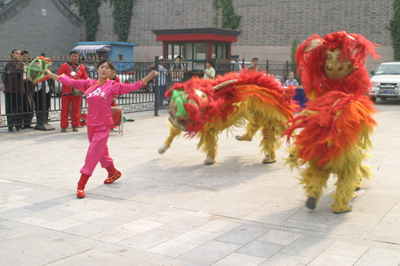| Tools: Save | Print | E-mail | Most Read |
| Lion Dance |
| Adjust font size: |
The Lion Dance is one of the most popular dances in China. Known as the king of animals, the lion is a traditional symbol of good luck in China. The dance has a long history stretching back 2000 years. Records show that during the Tang Dynasty (618-907), the Lion Dance was already performed for the royal family. In the Lion Dance, two people act as a lion; one moving the head and the other moving the body and tail; while one performer plays the part of the cub. The last dancer sways the silk ball with which the lion plays. Skill is vital while any one of the many kinds of Lion Dance which continues to be one of the most popular forms of dance amongst acrobatics troupes today. During the Lantern Festival and other festivals, the lion dance marks the beat of the frolics, bringing luck and happiness to all who contemplate it, if well-performed. Styles of Lion Dance The performances can be divided into Wenshi (civil lion) and Wushi (martial lion). Wenshi depicts a docile and amusing lion, playfully licking others and gently nodding off. Famous examples of this dance are the Luohan Playing with Lion in Sichuan and Hunan provinces and the Laughing Monk Playing with Lion in Shaanxi Province. Opposed to his friendly cousin, Wushi portrays the power of the lion. Besides the athletic jumping and tumbling, performers show off their techniques by climbing upon a high table or by stepping across five wooden stakes. For instance, the Gaotai (High Terrace) Lion Dance of Sichuan Province is performed on seven high tables, increasing the difficulty. In recent years, the Lion Dance in Beijing melded different stylistic elements to become a new style. Types by Geography In over 1,000 years of development, the lion dance has developed into two major genres -- Northern Lion Dance and Southern Lion Dance. The Northern Lion Dance has a longer history than all other forms of lion dance. It is said that in the Northern Wei Dynasty (386-534), Emperor Wudi launched an expedition to Hexi in Gansu Province, and captured over 100,000 Mongols. The emperor ordered the Mongols to dance for his entertainment. Over 30 Mongolian warriors held wooden carved animal heads, two large and five small, and clothed themselves animal skins, dancing before the emperor. The emperor was very pleased and named it Northern Wei Auspicious Lion, before allowing the captives to return home. The lion dance became popular across northern China, and the Northern Lion Dance was born. The Northern Lion Dance mainly focuses martial lion performances such as the Auspicious Lion of the Northern Wei Dynasty. The small lion dance is performed by one person, while its larger counterpart is carried ou by two persons, with one person wielding the lion head while standing, and the other holding up the lion body and tail in a stooped position. Guided by the lion dancers, the lion writhes, falls forward, jumps and takes a bow, accompanied by higher-flying maneuvers, such as walking on wooden or bamboo stakes, jumping over a table, and stepping on a rolling ball. There are several legends about the Southern Lion Dance in China. One of the legends surmises that in Qing Dynasty (1644-1911), Emperor Qianlong dreamed about the pilgrimage of an animal with bright fur on his inspection tour south of the lower reaches of the Yangtze River. After his return to Beijing, the emperor ordered his men to make a figure according to the image of the auspicious animal he dreamed about. He further ordered it to be paraded during festivals and ceremonies, to make the state prosperous and people peaceful. The Southern Lion Dance mainly focuses on the civilized lion dance. The performance focuses on movements like scratching an itch, shaking the hair, preening itself and so on.
(China.org.cn February 13, 2007) |
| Tools: Save | Print | E-mail | Most Read |
 |
| Related Stories |



